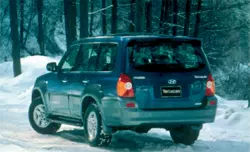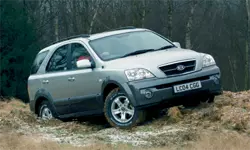|
|
|
Paul Talbot puts two off-roaders through their paces in anticipation of a wet winter...
With thoughts of staying mobile through all this adverse weather, we're kicking off a short four-wheel drive series.
Disabled Motorist was loaned a Hyundai Terracan 4x4 and a Kia Sorento 4x4, courtesy of both company's press offices.
Here's what we thought. 
Hyundai launched the Terracan in 2003 and added its highly acclaimed five-year warranty which gives total piece of mind. In terms of model range, it sits below Hyundai's other 4x4, the Santa Fe.
On the road
The car follows the traditional 4x4 route being a boxy fivedoor
vehicle, rugged looks with a go-anywhere capability. The car has a wide slatted grille, with teardrop shaped headlamps and driving lamps beneath. At 4710 mm long, 1860mm wide and 1840 mm high, it's quite a car, but we found that its size wasn't really a problem. The long roof and estate-like layout gives it this style of appearance.
Beneath the chunky wheel arches are alloy rims shod with huge 255/65 R16 size tyres. The rear door opens to 90 degrees and provides a good cover when unloading a wheelchair or scooter in the rain. Roof rails provide additional load carrying capacity if it is needed (which we doubt) and all the doors comfortably pass the “slam thunk” test suggesting a quality vehicle. Towing facilities are also included, which is good.
Interior 
Accessing a vehicle of this size from a wheelchair or, like me, a foldaway scooter, was never easy but achieveable, mostly with dignity intact. The seat height would be quite a bit higher than the base of the wheelchair we used but for the reasonably ambulant among us, it can be done. Once in, however, there's a definite “king of the road” feeling from behind the wheel of both cars in this test. Both hail from Korea and both have the indicators on the wrong side for the British market, which we found somewhat frustrating for a day or two.
As you'd expect, both cars are well specified with the Terracan having a single slot radio/CD unit, four electric windows, electric door mirrors and finger light power steering which is good when taking into account the size of the tyres.
Rather unconvincing, however, is the fake wood trim on the dash, steering wheel and gearbox housing. The seats give good support and were comfortable enough for a long journey but we found that the audio unit is fiddly to use with its small buttons.
Nevertheless, the sound quality is good, drowning out the sound of the diesel when pressing on.
The car has a 12v socket for charging or powering items
– possibly useful for charging a scooter when on the move
– and when it's stowed in the boot, there appears to be ample
room to carry the larger scooter without much trouble; it's low
and has a flat load area making easy work of the task together
with a useful cargo net to keep your transport safe.
Vehicle Specification
4 Speed automatic transmission
Electronic shift transfer “shift on the move” 4WD
Low ratio gearbox
Driver and passenger airbags
Anti lock brakes with electronic brakeforce distribution
Engine immobiliser aPower Assisted Steering with adjustable steering column
Side impact bars
Side steps (but no stepladder ! )
Air con/Climate control
Cargo net
Dual tone horn
Electronic chromic rear view mirror
Folding rear seat 60/40 configuration
Heated rear window with timer
Height adjustable front seat belts with pre-tensioners
Map reading lamps 
RDS Radio/CD with 6 speakers
Two tone side mouldings and bumpers
Electric heated door mirrors
Front foglamps
Front skid plate
Halogen headlamps
Headlamp levelling facility
Roof rails and bars
Technical Information 
Max power output: 120/160 at 3800 rpm
Max torque: 345/254 at 2000
Max speed: 106 mph
0-60 time: 13.4 seconds
Kerb weight: 2,255
Fuel consumption:
Urban: 23.7
Extra Urban: 37.6
Combined: 31 mpg
Verdict
The car's clattery diesel engine on start-up leaves you in no
doubt what's under the bonnet, but it pulls strongly when
required. We were disappointed in the steering; while light and
good for manoeuvres, it was decidedly vague on the road with
disappointing turn in. For a car that's probably going to spend
some or most of its time off road, it appears to be a capable
performer; we took the car to a variety of locations, some
totally inaccessible by a family car and it coped well in the
variety of situations and surfaces we threw at it.
Apart from the diesel engine noise filtering into the cabin,
the car is very well screwed together and we didn't detect
any rattles or annoying noises while on the move. Passengers
commented on the ample rear leg room and overall comfort
which is commendable. We also used the car in an urban environment, taking it to the Club's HQ in Northamptonshire and
while the car isn't particularly quick, we arrived relaxed and
ready for our appointment. Visibilty out of the car is good; the
ample amount of glass around gives plenty of opportunity to
see and be seen, which is good news.
The Kia Sorento has won an award courtesy of 4x4 magazine who voted it their Car of the Year, 2004. It was launched in February 2003 and according to the company, there's a three-month waiting list in the UK.
On the road 
The car comes in two trim levels, the XE and XS. Our test
vehicle was the XE and we feel it has a much more elegant
stance than the Hyundai; its tapered lights and nose result in
a car-like appearance together with a large grille and bumper
beneath housing spot lights. The bonnet rises from the tapered
nose and a straight waistline runs down the side of the car with a slightly thick D pillar towards the back of the car. The tailgate lifts in the same way as the Hyundai with the obvious benefits and roof rails provide the extra luggage space, if required. If access is limited, simply lift up the glass panel to gain access to the boot. Simple. Sat on chunky 16” alloys, this car looks every good from every angle.
Interior
Similar to the Hyundai, the car's driving seat is in an elevated
position and getting there can be a bit of a challenge. Once in,
good quality materials greet you with attractive brushed aluminium on the steering wheel and a well laid-out dash that's
easy to navigate around. Despite the indicators being set for
foreign markets everything else fell easily to hand but we've got the same criticism of the audio unit; it provides good quality
sound but is fiddly to use.
As with the Hyundai, passengers reported ample room in the rear despite its shorter dimensions and they commented specifically on the comfort of the seating.
As with the Hyundai, loading up the boot is a simple job. Our folding scooter could be placed in the boot by one person on their own, indicating that the sill is not too high and there's 890 litres of space on the flat floor. Once again, a cargo net was really useful. We also liked the under seat storage areas – useful for keeping those valuable items out of sight of prying eyes. Standard Specification
Power steering with speed sensing
Steering wheel tilt adjustment
Self levelling suspension
Sunvisors with covered illuminated vanity mirrors
Washer fluid low warning
Overhead console with sunglass storage & map lamps
Chrome door scuff plates
Gas strut bonnet lifters
Multi meter - compass/barometer/altimeter
Body coloured electrically adjustable heated door mirrors
Flip up tailgate window 
Heated rear window
Halogen headlamps
Load area light
ABS with EBD
Limited slip differential
Driver & passenger airbags
Side curtain airbags - front & rear
Front seatbelt pre-tensioners with load limiters
Three height adjustable rear head restraints
Rear cargo area cover
Front and rear side impact beams
Panic alarm facility
ISO fix child seat anchors
Technical Information 
Max power output: 138 at 3800rpm 192 at 5500rpm
Max torque: 343 at 1850-2500 294 at 3000
Kerb weight: 2,056-2,148
Fuel onsumption (Auto unleaded)
Urban (cold): 16.1
Extra urban: 29.1
Combined: 22.4
Verdict
The car felt more capable on the road than the Hyundai. Steering
was more precise and clearly there was less body roll than
its counterpart. Despite having less engine capacity, it felt the
quicker car despite being over a second slower in the 0-60 test.
We tried it on a similar route to the Hyundai and off road
there's little to choose between them. We noticed the major
difference in the urban environment; there was little road noise
from the tyres and its manoeuvrability shone through. We
weren't impressed by the overly light power assisted steering,
which had very little feel to it and a numb sensation when
attempting to establish what the wheels were actually doing.
The Result
Both cars are capable performers and have their own individual
qualities. We think that the Hyundai is the runner-up here
despite the car being just over £150 cheaper at £19,345 than
the Kia Sorento which is priced at £19,498. It's your money, but we'd go with the Kia as, on this occasion, we think it's a more refined car and in our opinion, easier to live with, not to mention Kia's offer of a £1 deposit. Both are capable off roaders, and if this rain keeps coming down, we'll need it. Just where did I put that pound coin ?
Thanks to Jodie Streeter at Hyundai and Sue Cugely at Kia for
arranging the tests. Hyundai: 0800 981 981 or www.hyundaicar.
co.uk. Kia: 0800 77 57 77 or www.kia.co.uk.
The Disabled Drivers' Motor Club wants you to spend your
money wisely. There are a number of assessment centres
around the UK for you to discuss your mobility requirements
and we urge you to contact them before you commit your funds
to a vehicle that may not be suitable. We can provide you with
a leaflet with contact details of your nearest centre. 
|
|
|
 |

